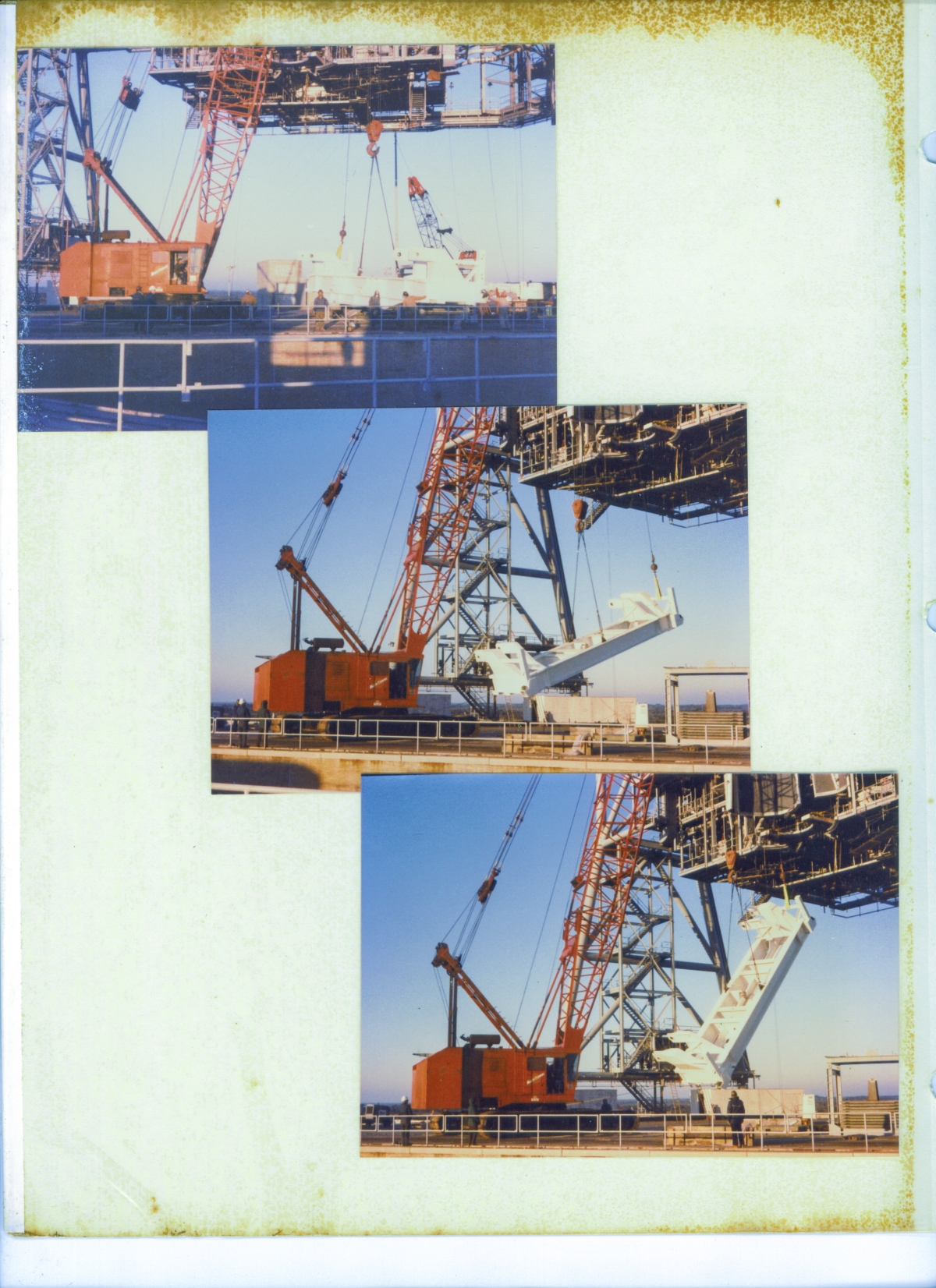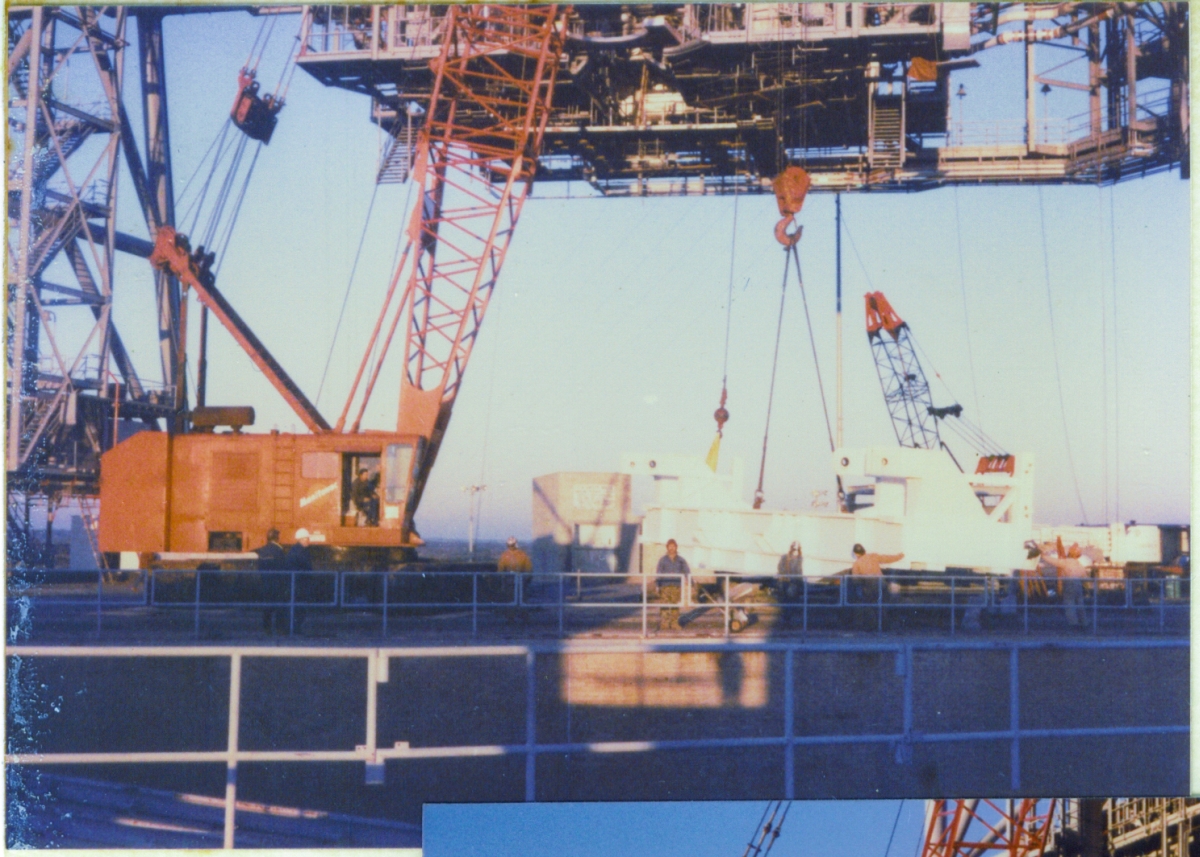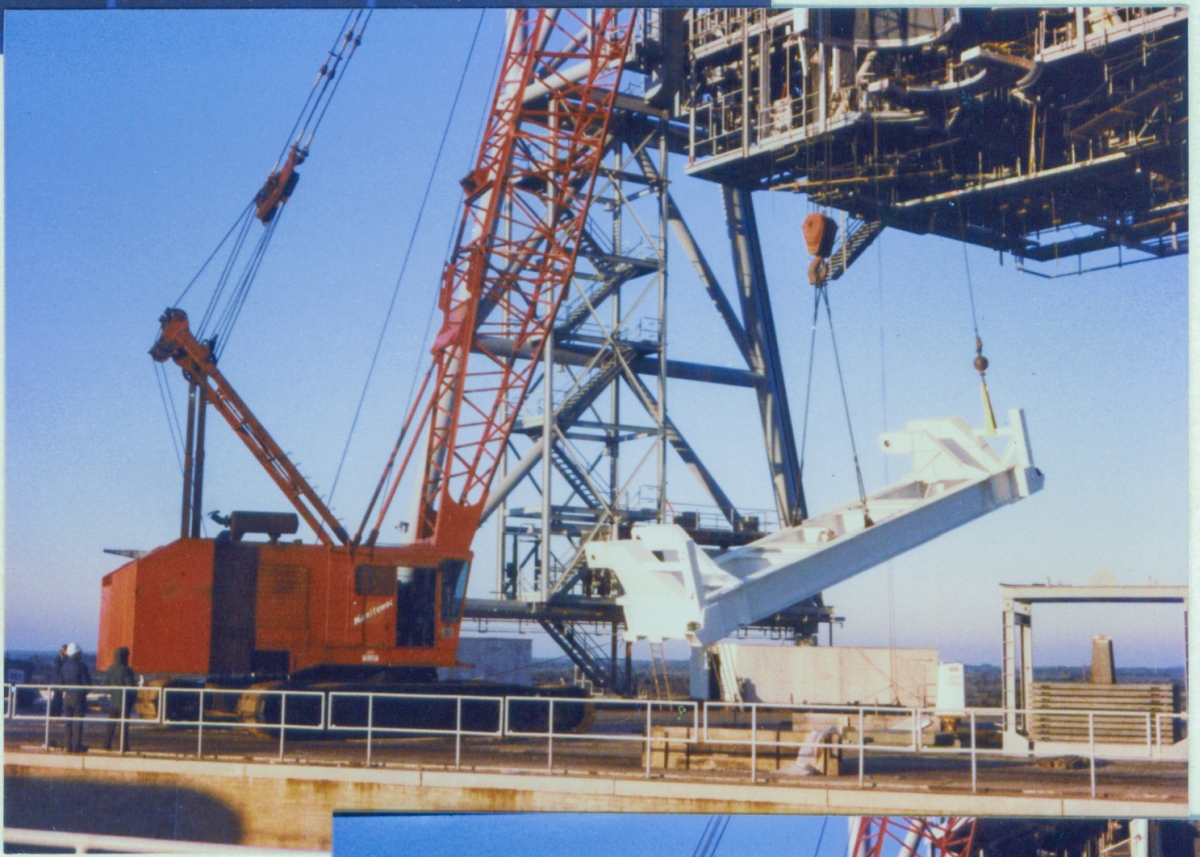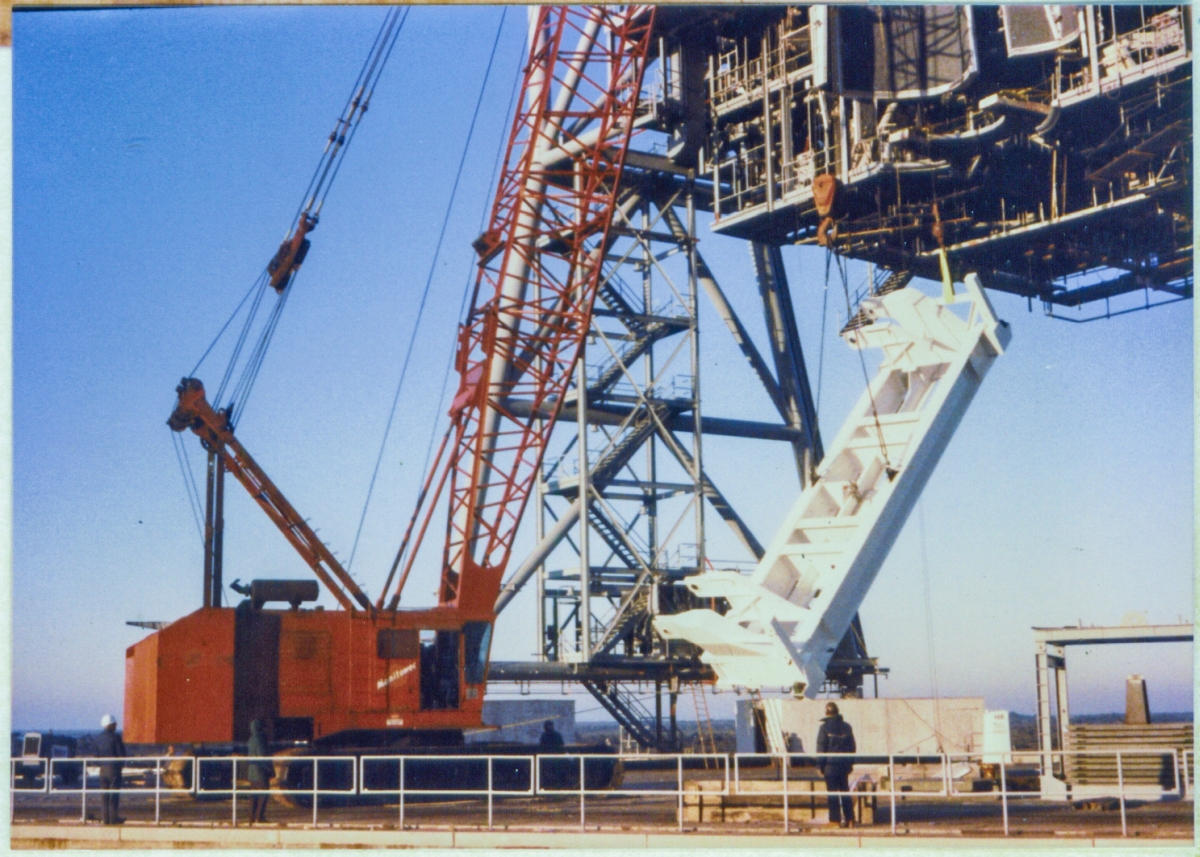Space Shuttle Launch Complex 39-B Construction Photos
Page 12
PGHM Bridge Beam Lift, Page 1 (Original Scan)
This was one of the most amazing things I ever saw during the whole time I worked out on the pad, and is a sterling example of Ironworker Cunning.
This bridge beam is BIG, and it barely fits into the PCR, and if that's not enough, it sits up on a set of support rails up into the very top of the PCR. And yet, using a plain vanilla Manitowoc crane, the crew with Ivey Steel successfully worked that monstrosity into place, up there just beneath the PCR ceiling. Took 'em all day long, and at one point well after dark had fallen, and the thing was all kinds of twisted and shoved up in there with come-alongs tied to it from every direction and curse words befogging the air, Wade Ivey sent me to the Kentucky Fried Chicken for eats and when I got back we all stopped and took a well-deserved break. They were still going at it hammer-and-tongs when I departed (I was management and was as useless as tits on a boar hog for the purposes of physically helping with the work), but when I arrived at the pad bright and early the next morning, damned if the thing wasn't right where it belonged! I dimly recall someone saying it took 'em till two or three in the morning, but that may be a bad recollection.
Truly an amazing accomplishment!
Additional commentary below the image.

Top Left: (Reduced)

It's early morning on one of those days right after the cold front comes through with a biting northwest wind putting a most unFlorida-like chill in the air. The sun is just barely over the horizon, and already the light is brilliant and sharp.
Most days in Florida, the light has this softness to it that is hard describe, but is also very noticeable, just the same. But not always. Once in a while, the light takes on a desert aspect, with greatly-heightened clarity.
You're up on the pad deck, which right away places you fifty feet above the level of the surrounding landscape, and the wind has a cut to it that you do not feel when you're down on the ground. People are wearing gloves. People are keeping their hands in their jacket pockets. The steel is all cold as hell to the touch. Florida cold is a funny thing, and I've heard over and over again from people who came down from up north that a thirty-five degree morning in Florida felt colder to them than a five-below morning back home in Michigan or New York, or wherever. People say it's the humidity that causes this effect, but I really do not know. What I do know is that it was fucking cold this morning and we were all out there completely exposed to the elements.
The PGHM bridge beam is going up.
There's a lot going on, zoom in on these images whenever and wherever you need to.
Ok, first off, let's talk about cranes. There's two of 'em.
The big Manitowoc is blazingly obvious, but the other rig is hidden behind the right-hand side of the bridge beam, and all that's visible is its little stub boom sticking up over the right-hand "ears" of the bridge beam.
The Manitowoc is hooked on to the bridge beam twice, once with the main load line, which is hooked to a two-part sling more or less right in the middle of the bridge beam, and again with the jib line, on the far end of the beam as seen from this point of view. Look close, and you'll see that one of the attach points to the bridge beam is a nylon sling. This is significantly less secure and safe than using steel rigging from one end to the other, especially on objects of this size and mass, and is a direct result of having to endure the ruinously fucked up dictates of the goddamned KSC-STD-C-0001 corrosion control spec, and the bizarrely and maliciously overbearing assholes who enforced its rules to the last jot and tittle, in a field environment where gigantic pieces of iron had to be jostled and jockeyed into position against each other. The fuckheads riding herd on that end of things deliberately and maliciously chose to pretend that not so much as a single scratch could be endured upon their precious three-coat-system, and that the contractor was supposed, somehow, to erect a cyclopean steel structure literally without scratching things! I really do wish I was kidding here, but I am not. The level of dangerous stupidity on the part of the corrosion control experts, and one of them in particular who shall remain unnamed, regularly and routinely went completely off the scale, and the number of near-misses, mishaps, and life-threatening accidents that occurred as a direct result of their criminally out-of-touch directives and instructions was uncountable, and it was all for nothing, because in the end, everything got touched up or even completely sandblasted down to bare metal and repainted from scratch, in part, or in full, after it was installed, and what the fuck were these idiots thinking, when they demanded finish coats on everything that was delivered to the job site, before the first lifting sling ever got attached to any of it? It's been a looong time, and yet it still has the power to make my blood boil whenever I think about it.
Alright, calm down MacLaren. Nobody got killed. It's going to be ok.
Our crane operator in the Manitowoc is going to have his hands full with this one, simultaneously swinging left or right, booming up or down, working the jib, and lifting or lowering with both the main hoist and the jib line, each one independent of the other.
And, just to spice things up a little, it must never be forgotten that the simplest of lifts are dangerous, and the mathematical complexities and consequences of constantly varying centers of gravity, moments of inertia, leverages, clearances, strengths of materials, and a bewilderingly vast array of other unforgiving considerations, constantly hovers silently in the background, just waiting for the least bit of inattention, misapprehension, or miscalculation, where it will strike without warning, producing lethally catastrophic results.
This lift was no fucking joke, and everybody concerned was all-too-aware of that, and equally all-too-aware of the potential results should things go badly wrong.
Our second crane, hiding back there behind the bridge beam is very very interesting. Please note that the line coming off of the head sheaves, at the top of that stub boom, goes up and not down! Furthermore, when you zoom in really close, you can see that this line, going up into the RSS, passes behind the run of piping and cable trays that extends into the frame from the FSS, just out of view on the right-hand side, which places it on the back side of the RSS, extending up for an unknown distance to a snatch block or two, or three, somewhere well-hidden from view.
This is part of the rigging they're going to be using to muscle the goddamned bridge beam into place, and the fact that they're using a crane instead of a tugger tells us that they're planning on exerting a pretty hefty amount of force on things, some where, at some time, during the proceedings, and that they might also be needing a bit of mobility, too.
Lifts can get extraordinarily complicated and this is probably the most complicated lift I ever saw.
Around the now-suspended bridge beam, our ironworkers can be seen managing its orientation (which is by now already more or less in it's final, to-be-lifted-in, state) while the crane operator pivots around to the left to get things where they properly belong, before they really start to gain sensible elevation. The weight of the jib line and its headache ball are wanting to twist the beam's orientation around parallel with the crane boom, and these guys are seeing to it that this does not happen.
Extra-large and heavy objects, when in a condition of being suspended from very high above, have a very peculiar aspect to them in that they sort of float. Their great inertia keeps them from just being tossed around this way or that, but they can nonetheless be moved or rotated with a surprisingly light push. Give something like this bridge beam the heel of your hand, and shove it, just a wee little bit, and at first it will act like it doesn't quite know what you want it to do, and fail to respond, but then, with continued shoving, it quickly changes its mind and starts to pick up speed, and if you're not careful, you'll overdo it, and then have to deal with where it's going, and what it's going to do when it gets there, and what it's going to do when it swings back, in the knowledge that its great mass and inertia will cause it to just want to go right on through things without stopping. This sensation of giving a large massive object a bit of momentum is for some strange reason pleasurable, and kind of fun to do. But you gotta watch it. You can't just be playing around with this shit. You'll fuck somebody up, and if you do, they're very naturally going to want to come back and fuck you up in return.
Staring directly into the camera (and the sun, more or less) from across the flame trench, appears to be John Foster. To the right of John, it looks like James Dixon, facing away from the camera. Standing in shadow, all but their heads, two gentlemen are directly between my camera and the Manitowoc, and my guess is that the guy on the left is Wade Ivey, and the guy on the right might be my boss, Richard Walls, but he was a pretty tall guy, and I'm not sure this guy is tall enough to be RW.
Everyone else in this image must, alas, remain unidentified. If you look at the far wall of the flame trench, below John Foster, you can see a sunlit area, where the light is coming through between the field trailers behind me as I took this picture. Between John and James, in that sunlit area of the flame trench wall, you can see the shadow of whoever it was that was standing right next to me as I took this photo. No recollection of who that was, however. The location of that person's shadow on the wall serves well to indicate the very low angle the sun is shining across from, just above eastern horizon. It was a really clear day, this day.
This image, when you're zoomed in on it so as it completely fills your screen from side to side, also gives just the slightest hint to that curious sense of the RSS, which by now you should have some sort of rudimentary understanding for just how gigantic it is, slung up and aboveground into the goddamned sky for god's sake, and you can see just the barest little bit of the bottom of it, as the rest of it floats on up and out of the frame, like an ocean liner filled with helium or some other goddamned ridiculously impossible thing. And yes, I'm going on about this aspect of things far too much, but no, I'm not going to stop, because goddamn....
Center: (Reduced)

Ok, now we're getting a little somewhere, and I've walked north, along the east side of the flame trench, in order to get a better angle on the bridge beam, as it goes up into the air. It's going to be a tight squeak getting inside the RSS through the PCR Doors, and the crane operator is already coming up a little on his jib line with respect to the main hoist, tilting the bridge beam into a more vertical orientation where it can be worked in through the narrow opening it must go through, up above, out of frame.
Also notice that the damn thing immediately looses some of its size and mass now that there's nobody in frame, right next to it. The human eye is a funny thing, and we're never really seeing what we're seeing.
To the right, down on the pad deck, that square gray open frame with the stack of somethings inside of it is a test weight, furnished by NASA, and just going on looks alone, it might be for the 90-ton payload canister hoist proof-test. Out on the Cape, everything gets proof-tested. Every last bit of it. It's not nearly enough to simply furnish and install something. Oh no. After you've done that, you're going to demonstrate that it works.
"Did you build us a nice 90-ton hoist?"
"Yes, yes we did, and it's very nice indeed."
"Is that right?"
"Oh yes it is."
"Oh no it's not. Here, here's 120 tons of dead weight. Now go and pick it up with your nice hoist, pretty please, so we can see for ourselves just how nice it really is."
"Roger that, no worries mate, kindly clear the pad deck, hook the sonofabitch on, and let's go."
"Ok, it went all the way to the top, and back down to the bottom, with lots of stops and starts in between, and it didn't break. How about that? Very well then, here's your draw against that part of the contract, and we thank you for your support and cooperation."
"Any time, guys. Any time at all."
This sort of thinking seems to have left a permanent scar on me, and to this day I find myself unthinkingly giving anything and everything I make or fix, a proper functional test prior to handing it over to someone, even if that someone is me. And you know what? Every once in a great while, it's a good damn thing I did so, because things don't always work perfectly like they're supposed to. My little free-lance computer repair gig I do as my main source of income has benefited greatly from this approach to things, and I'm sure I'll never change my ways, at least in these regards.
Also, once upon a time NASA drove one of these big test-weight fixtures southbound, carried on a low-boy trailer, directly into the overpass where the Nasa Causeway goes over State Road 3, pretty much right in the middle of Downtown Nasaville. Fucked up the overpass pretty good, with that one. The frame for the test weight didn't seem any too messed up, but that stuff is strong, right?
A couple of pages ago, I mentioned having to make a snap decision regarding running for my life, or not, and one of the potential avenues of escape is mentioned as being the emergency egress stair tower on Column Line 7, on the far side of the RSS. In this picture, and the one below, you're getting a pretty good view of that stair tower, draped down across the main structural framing of Line 7, as the backdrop between the bridge beam and the crane boom, right in the center of the frame.
Bottom Right:

And now that the bridge beam is tipped up on one end, you can get a pretty good look at its overall configuration. It's really strong. Well-braced. Well-stiffened. Typifies nicely the dictum of "When in doubt, make it stout."
And some goddamned way or other, it's going to go inside the PCR, damn near all the way into the rafters, and this is not going to be a trivial thing, getting it in there.
Return to 16streets.comACRONYMS LOOK-UP PAGEMaybe try to email me? |